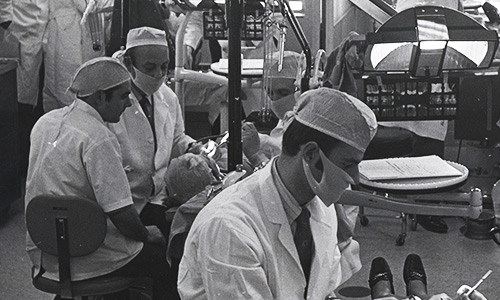What’s in a name?

This “Impressions” page is designed to capture a moment in time in the rich history of our Dallas dental school. The people of Texas A&M University Baylor College of Dentistry have called the school by various names: State Dental College from 1905 to 1918, Baylor University College of Dentistry from 1918 to 1971 and Baylor College of Dentistry from 1971 to 1996, when the name became longer to reflect the affiliation with the Texas A&M University System. Through the ebb and flow of history, the dental school has been nurtured by people who reaped its benefits and perpetuated its legacy. Enjoy this glimpse into the mirror of time.
Editor’s Note: As the Texas A&M Health Science Center anticipated merging with Texas A&M University in 2013, many questions about details remained to be answered. One hot topic in 2012, separate but akin to merger discussions, concerned the dental school’s name; word came in mid-December that “Baylor” would remain. Thus the inevitable question from some: Why is “Baylor” in the name anyway? From the perspective of many alumni advocates, why not? The following dean’s message demonstrates that issues of affiliation, name and funding involve our past as well as our present.
The Baylor Burr, 1971
A New Era for Dental Education at Baylor
On August 1, 1971, the operation of the College of Dentistry began as a private, nonprofit, nonsectarian corporation under the authority of a newly designated Board of Trustees. Historically, the college was first chartered as the State Dental College, February 28, 1905, and came under the ownership of stockholders. For the period 1916 to 1918, an Advisory Board of Dallas dentists was responsible for the affairs of the college, the name of which remained the same. On May 28, 1918, the school became a part of Baylor University and, as such, it was owned and operated by the Baptist General Convention of Texas. The name was changed to Baylor University College of Dentistry. The period of university and denominational affiliation terminated July 31, 1971, and a new charter was issued with the name, Baylor College of Dentistry.
Three basic factors were instrumental in bringing about the recent change in status of the College of Dentistry, (1) the need for more dentists in Texas (2) the preservation of an established dental school rich in tradition and reputation, and (3) the need for increased financial support. The Baylor University Trustees agreed to an expansion program if state support was made available. Enabling legislation became law in 1969, and funds were appropriated in 1971, both of which were subject to a separation from any religious connection.
After sixty-six years and five months, a new chapter has begun for dental education in Dallas. It is expected to represent an interesting and exciting period of many changes. The size of entering classes in dentistry should increase to 150. Temporary facilities will accommodate additional students until more permanent additions can be arranged. More faculty and staff, as well as marked variations in the curriculum, are imminent.
Dreams for the future of a school prompt an appraisal of the past. There is just no way to give adequate credit to the dedicated people who have made Baylor College of Dentistry what it is today. Special tribute should be given, however, to the Trustees and Administrators of Baylor University and to the Baptist General Convention of Texas for the 53 years of continuous management and support of dental education. May the future of the school be marked with an unmatched loyalty of supporters and an unexcelled progressiveness in the program.
Kenneth V. Randolph, Dean
Dean Randolph was the college’s 12th dean, serving from 1968 to 1980.